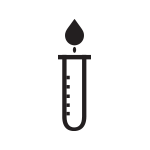With this service you will receive a home finger prick test. Our most comprehensive analysis of female hormones that impact the menstrual cycle, and fertility. Also added a comprehensive thyroid profile to assess its health and function.
If you are trying to get pregnant, high levels of thyroid specific antibodies in your blood could increase your risk of suffering a miscarriage. This can be the case even if your levels of thyroid hormones (FT3 and FT4) are within the normal range. An undiagnosed, and therefore most likely untreated thyroid disorder can also increase the risks during pregnancy to both the mother and the foetus.
For this reason, our Female hormone tracker advanced includes a comprehensive and increasingly extensive thyroid profile. This involves testing for FT3 in addition to antibodies present against the thyroid (thyroid peroxidase antibodies and thyroglobulin antibodies) to provide a better picture of the health of your thyroid. The detection of thyroid specific antibodies is also important in assessing whether an autoimmune disease is present.
As included in our basic package we also test for the most important hormones associated with a woman's reproductive system. The tests included can help you understand whether symptoms such as painful periods, acne or alterations to mood are being caused by a hormonal imbalance. The test may be used to diagnose PCOS and other underlying issues regarding fertility and difficulty trying to conceive.
This is perfect for females experiencing the following:
Caution: Receiving hormones either during hormone replacement therapy (HRT) or from contraceptive sources including; the pill, the hormone IUD or the implant will affect your results. To give a true indication of your natural hormone status requires the ingestion of these types of medication to be stopped for at least 12 weeks prior to testing. During this period, it is advised alternative methods of contraception are used if pregnancy is not desired.

We send you an easy-to-use kit to collect your blood sample.

Post your sample to our lab in the prepaid envelope provided.

View results securely in your own personal dashboard.
© 2023 All Right Reserved. Bio Healthcare Networks